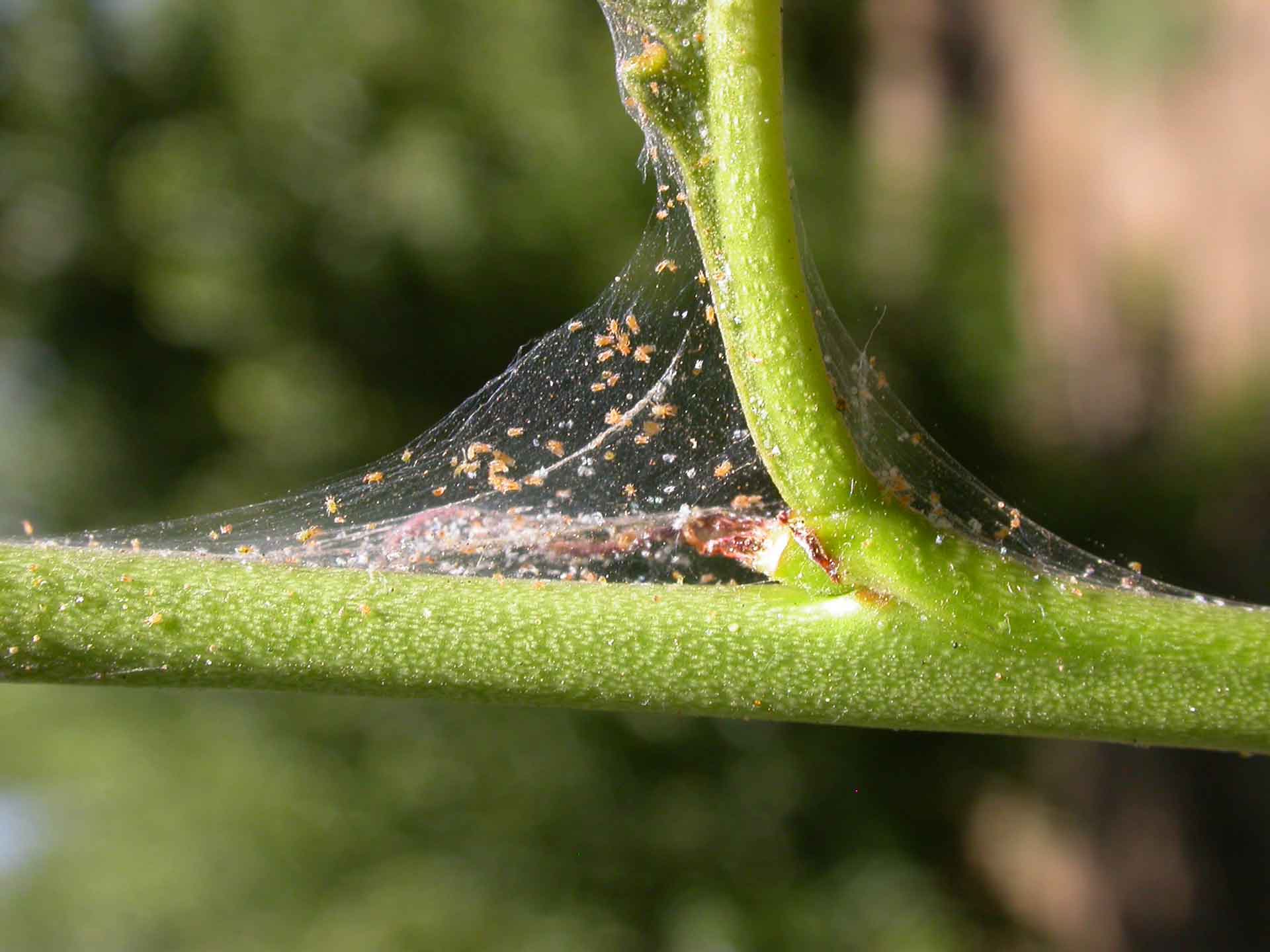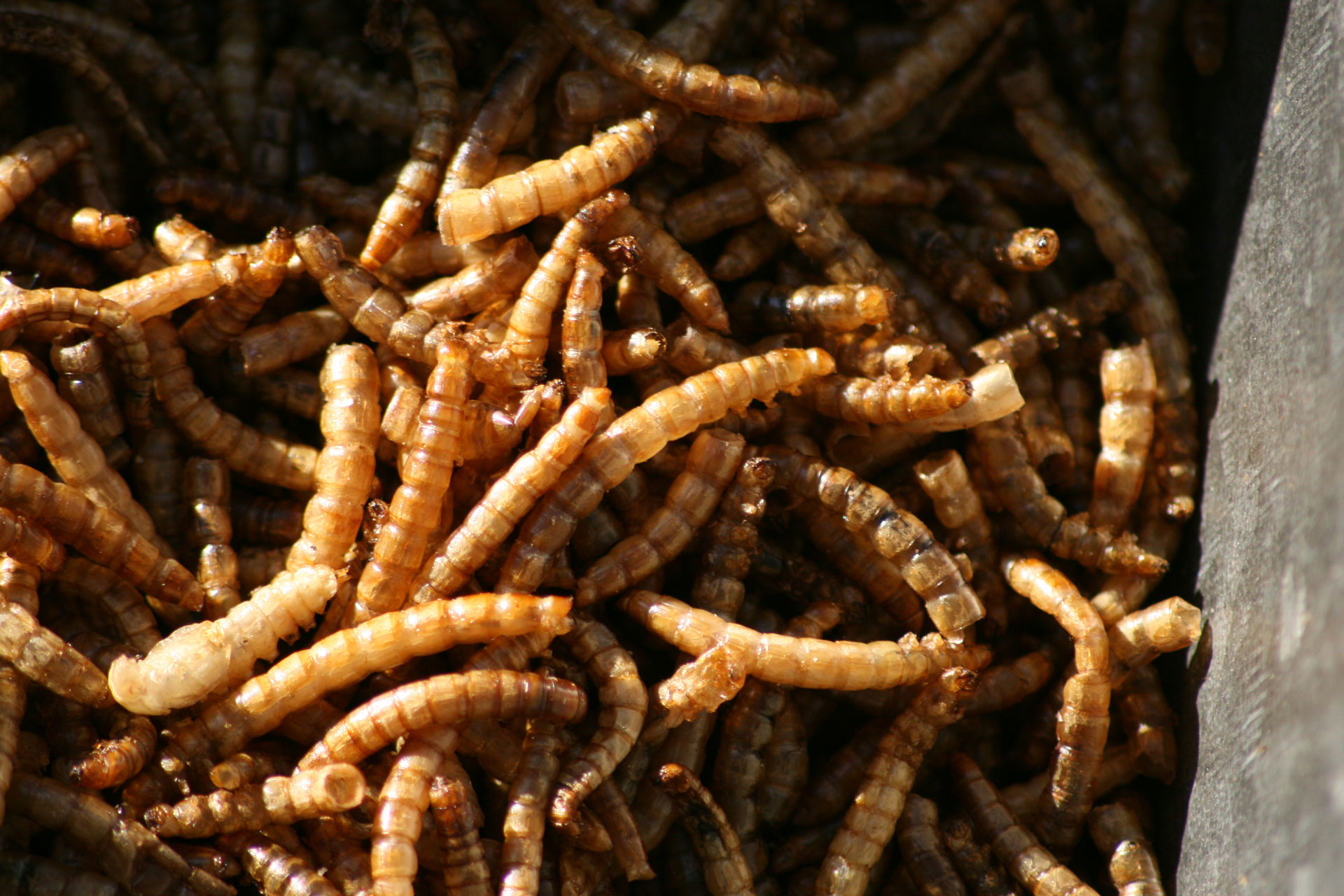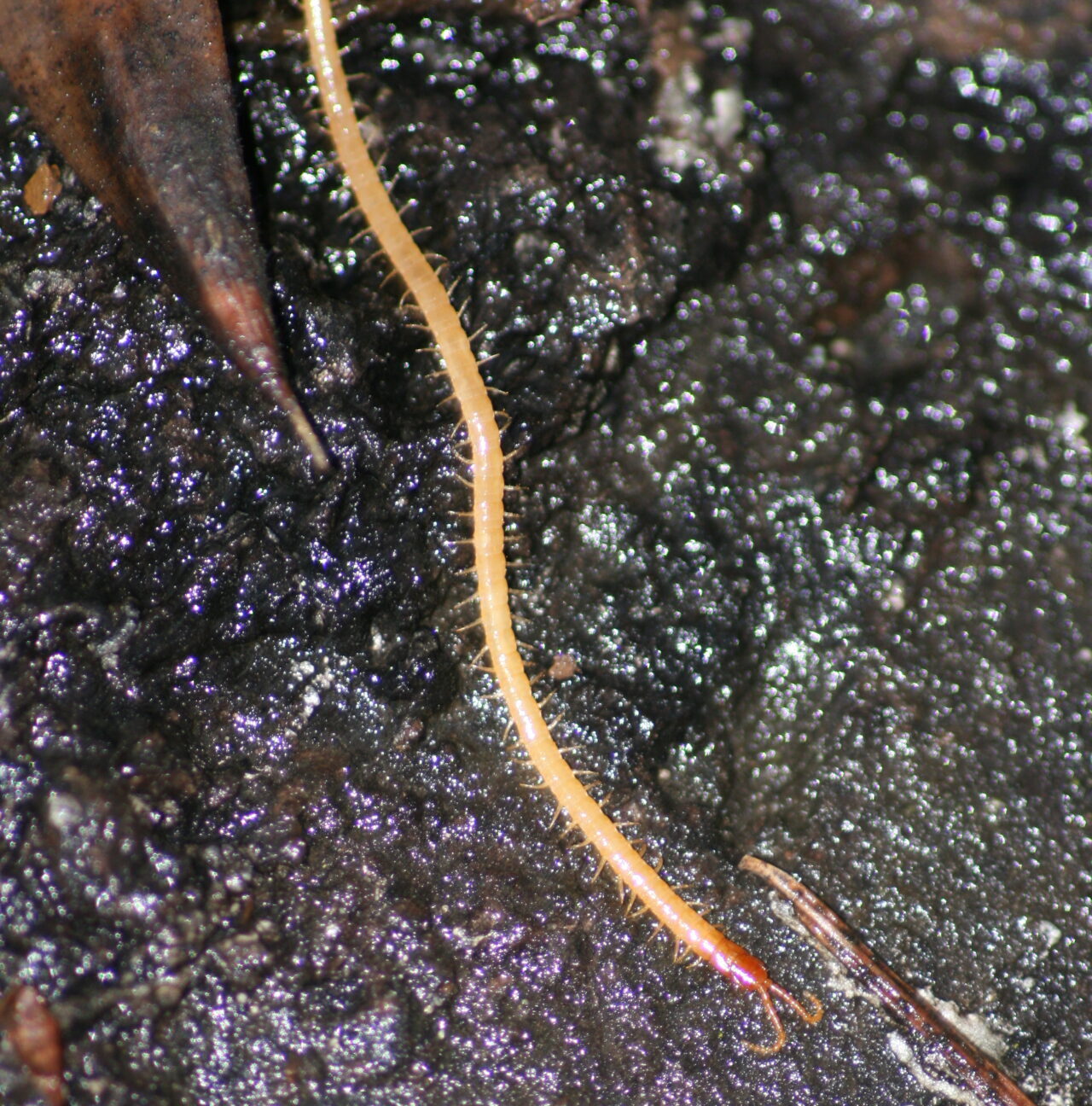Management programs for spider mites in tree and vine crops are a classical opportunity to implement integrated pest management (IPM) practices. It requires proper identification of the mites, monitoring programs that include both pests and natural enemies, treatment thresholds that consider biological control, and in some cases miticides. When IPM practices are in alignment, biological control is often sufficient to provide season-long mite control. When chemical controls are needed, choice of a selective miticide that has minimal impact on natural enemies helps maintain the integrity of an organic production system.
Proper Identification
For deciduous trees and vines, the most significant spider mite problems are caused by Pacific and two-spotted spider mites. These two species have a nearly identical appearance in the field. During the winter they are orange in color while adult females hide in protected areas, such as in leaf litter or under loose bark. During the spring, typically in March or April, they move up the tree or vine and take on an amber color after feeding on green leaf tissues. Spider mites are generally slow moving and are often found in association with webbing (Fig. 1). They lay spherical eggs within this same webbing. Both species have two spots on their abdomen, for which the two-spotted spider mite gets its name.
Spider mites need to be distinguished from predatory mites, also called phytoseiids, which are an important natural enemy of spider mites. Phytoseiids are typically amber to clear-colored, have a tear-drop shape, and are shiny due to a lack of hairs. They do not produce webbing. Phytoseiids do not have spots on their abdomen, produce conical eggs that are often found within spider mite webbing, and are often seen moving quickly on the leaf surface.
Monitoring and Treatment Thresholds
Monitoring programs for most tree and vine crops can be found at the University of California Statewide IPM Program web site (http://ucipm.ucanr.edu) by clicking on ‘Agricultural Pests’, then selecting a crop, and then clicking ‘webspinning spider mites’. In most commodities, monitoring efforts begin by evaluating individual leaves or leaflets for the presence or absence of spider mites and natural enemies. This should be done in multiple locations within an orchard or vineyard, and can typically be done rather quickly, especially considering that counting individual mites or natural enemies is not required. These data are used to calculate a percentage of leaves with the presence of spider mites and natural enemies that can be compared to published guidelines regarding the need to treat for each commodity (Table 1). Pest Control Advisors (PCAs) are encouraged to keep written records of their monitoring efforts, such as on the forms linked in Table 1, to justify their treatments. These records are also beneficial when looking at multi-week trends in mite populations. For example, should an almond PCA be concerned if 20 percent of almond leaves are infested? The answer depends on the context. If multi-week sampling shows that it was only 5 percent last week, intervention is likely required. If it was 50 percent last week, then 20 percent infested leaves this week indicates that natural enemies will likely be adequate to provide control.
Table 1. University of California Statewide IPM Program monitoring forms and treatment thresholds.
- Almond Treat if 25% or leaves have mites and there are no natural enemies, or if one third of the leaves have mites and natural enemies are present. http://ipm.ucanr.edu/PMG/C003/almonds-mites.pdf
- Walnut Treatment decisions are made by sampling leaflets in the top and bottoms of the trees. Avoid treatments if predators are present on at least half of the leaves. If predators are present on fewer than 10% of infested leaves, spray when 10% of the leaves have spider mites. If predators are present on more than 10% of infested leaves, spray when 20% of leaves have spider mites. http://ipm.ucanr.edu/PMG/C881/walnut-mitemon.pdf
- Grape Treatment decisions are determined by comparing mite injury levels (light, moderate, heavy, or very heavy) to predator-prey ratios (predators are rare, occasional, frequent, or numerous). http://ipm.ucanr.edu/PMG/C302/grape-leafhoprmite.pdf
- Peaches, nectarines and plums Use presence-absence sampling to determine a mite rating (low, low/moderate, moderate, moderate/high, high) that is compared to a predator rating (low, moderate or high). A treatment should be made if there is a low/moderate mite rating with a low/moderate predator rating, or a moderate/high mite rating with moderate/high predator rating. http://ipm.ucanr.edu/PMG/C602/peach-mitesampling.pdf
- Cherries Treat if the number of leaves with spider mites exceeds the number of leaves with natural enemies, or if week-to-week sampling indicates that the percentage of leaves with spider mites is increasing while the percentage with natural enemies stays the same, especially if large numbers of spider mite eggs are found. http://ipm.ucanr.edu/PMG/r105400211.html
Biological Control
Natural enemies play a key role in regulating spider mite populations in all commodities, especially in ones grown organically. It is for that reason that monitoring for natural enemies is critical when making the treatment decisions that were previously described. The diversity of natural enemies changes according to commodity, geography, regional diversity of cropped and non-cropped areas, and history of pesticide use.
Phytoseiids—There are approximately 70 different species of predatory mites in California. In a statewide survey led by Dr. Grafton-Cardwell, a team of extension farm advisors and specialists from the University of California documented that the species differ among crops, different climatic regions of the state, and at differ times of the year. Some phytoseiids, such as Galendromus occidentalis, are excellent predators of spider mites, while other species, such as many in the genus Euseius, prefer to feed on pollen. Regardless of the exact species and feeding preferences, all predatory mites are known to benefit biological control programs. Growers should monitor for them and protect them if present. Several species that are important in trees and vines, such as Galendromus occidentalis and Neoseiulus californicus, can be purchased from commercial insectaries and released to augment natural populations, particularly in the spring.
Six-spotted thrips—Over the past decade sixspotted thrips has become the most important mite predator in California almonds, and has been known as an excellent mite predator in stone fruit for several decades. Sixspotted thrips get their name from spots on the wings of the adults (Fig. 2). They are voracious feeders and exclusively eat mites and mite eggs, with the exception that they will also eat each other when their preferred food is scarce. They thrive in hot, dry conditions and are very good at navigating within spider mite webbing.
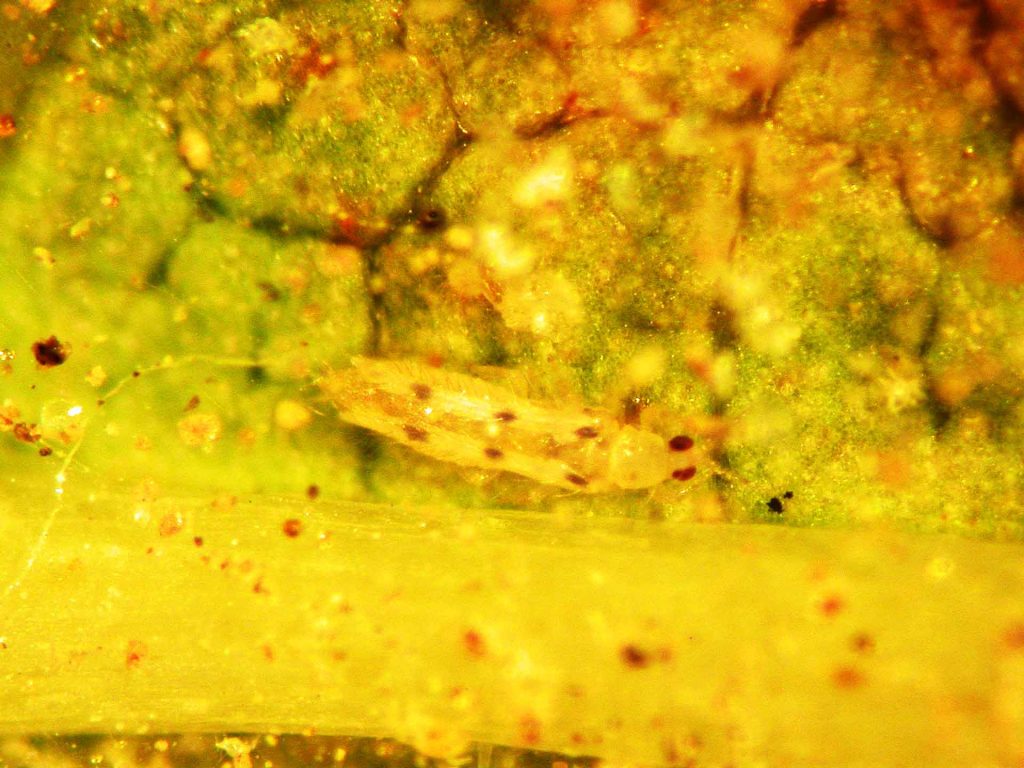
Over the past few years, yellow sticky cards have been shown to be the preferred way to monitor for sixspotted thrips. The most effective is the small yellow strip trap (3 inch x 5 inch) that can be purchased through Great Lakes IPM (Fig. 3). Cards can be hung from a tree branch using a binder clip and large paper clip near the locations of other traps, such as pheromone or egg traps for navel orangeworm, peach twig borer, codling moth or oriental fruit moth. Traps can be checked weekly to determine the number of sixspotted thrips present (Fig. 4). Data from almonds show that if one thrips is found per card per week, there is no need to use miticides in April or May. In June and July, if there are three thrips per card per week there is a 50 percent chance that mites will be the same or lower within 14 days. If six thrips are found per week there is a 72.7 percent chance mites will decrease within seven days, and 96.6 percent chance they will crash within two weeks.
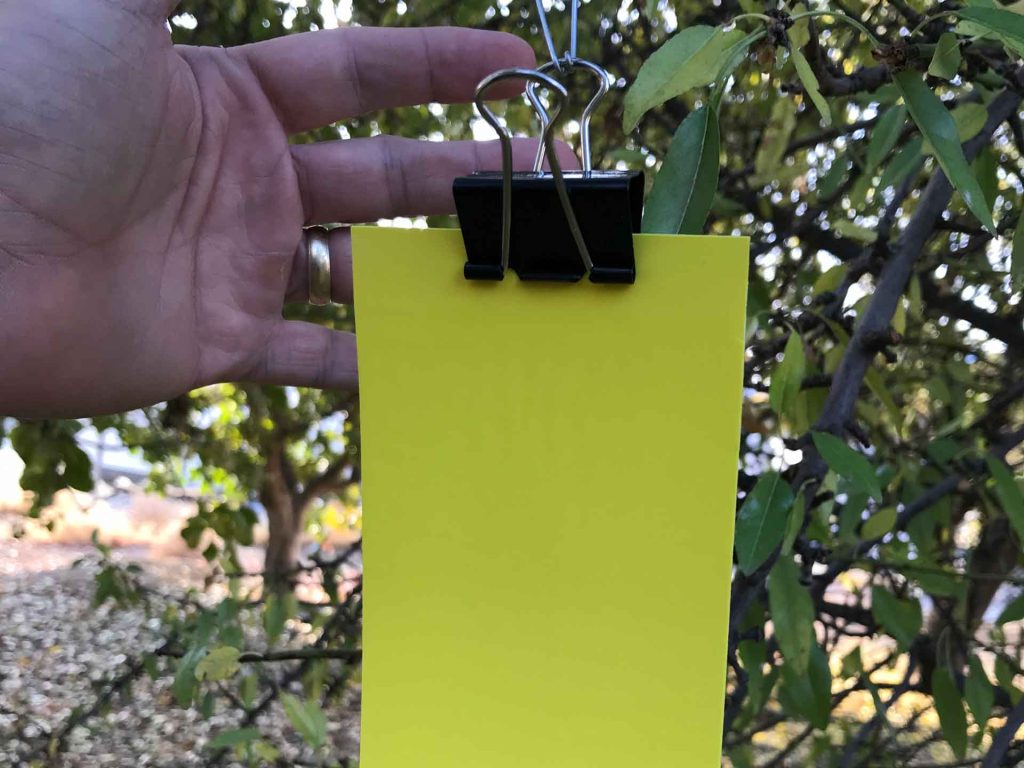
Mite destroyer beetles—Small black ladybugs, called mite destroyer beetles, are commonly found in orchards with spider mites (Fig. 5). This beetle feeds exclusively on mites. Advantages of this species are that they eat many mites, and live a long time. Disadvantages are that they develop slowly and do not often appear until very late in the season, long after they were needed. For this reason, it is important to observe and protect this species, but probably not wise to overly rely on it for mite control, especially during the spring and early summer when mite management is most critical.
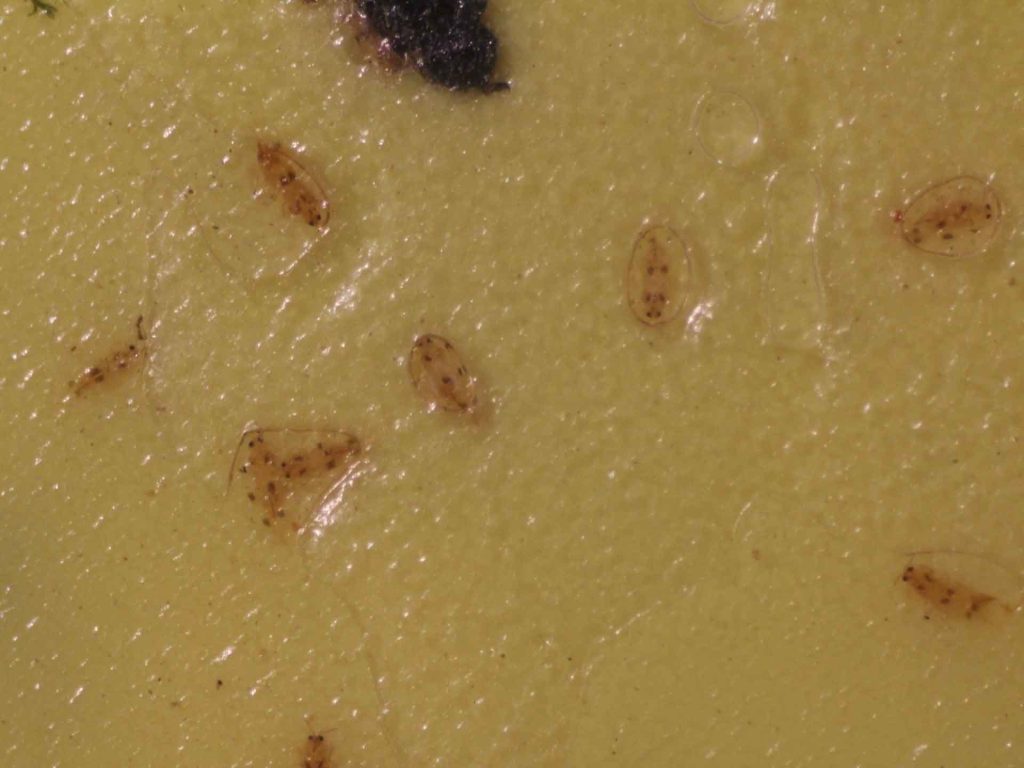
Other predators—There are several other species of insects that feed on spider mites. Some of the most common are minute pirate bugs and green and brown lacewings (Fig. 5). These species are generalists and also feed on scales, mealybugs, aphids, and other pests in trees and vines. These generalists have an advantage that they can survive on many different foods while mites are absent and be ready to eat the mites when they appear. Conserving these beneficials is of great importance in an organic system.
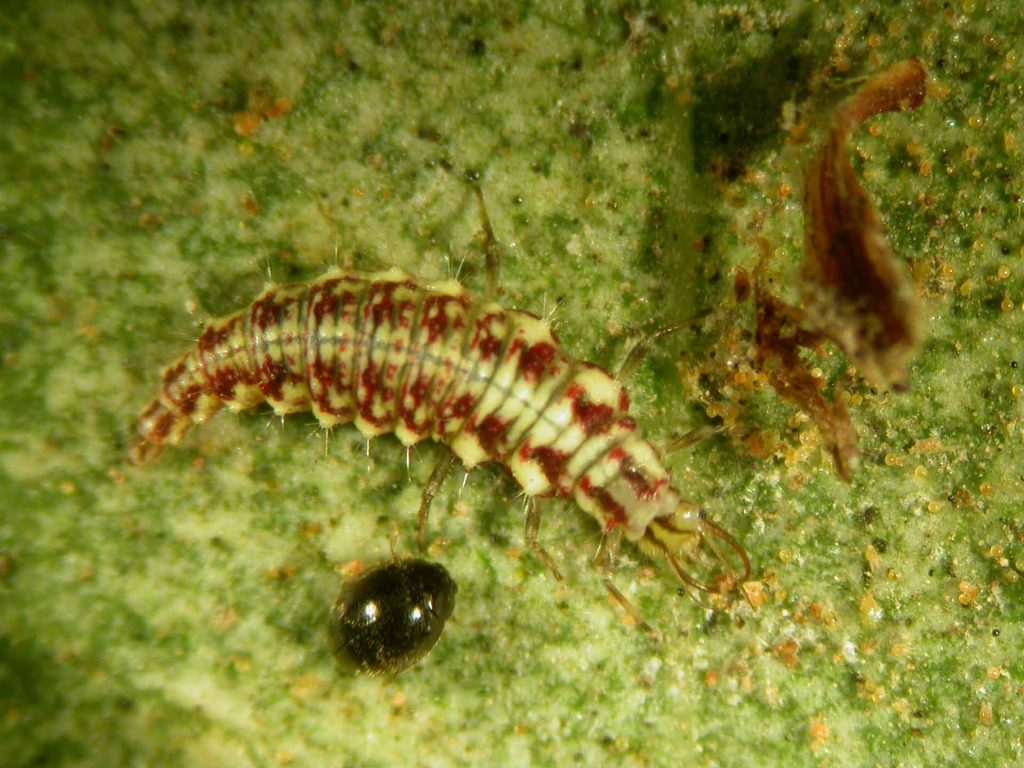
Cultural Controls
Spider mites respond directly to plant stress by increasing their populations. This can be stress due to water, such as insufficient irrigation, that is either accidental or done intentionally (such as deficit irrigation practices used to improve wine grape quality or to synchronize hull split in almonds). It can also be caused by poor nutrition programs, excessive heat, root systems damaged by nematodes or disease, or even a heavy crop load. Dust also promotes spider mites. It is for that reason that many growers are adamant about adherence to speed limit signs on the farm. Growers that limit dust in their trees and vines, have excellent irrigation and fertilization practices, and are good at managing nematodes and diseases, typically have less problems with spider mites.
Miticides
There are occasions where biological and cultural controls are insufficient to provide adequate spider mite control. In this case, when thresholds dictate the necessity, miticides can be used. Most of the miticides available to organic farmers are oil-based, with many containing plant-based oil extracts such as clove oil, rosemary oil, garlic oil, or extracts from plants such as chenopodium. Oil-based pesticides kill mites by causing them to suffocate, with some products also having other toxic effects. During 2018 we evaluated three examples of oil-based miticides, including Biomite, TetraCurb and Cinnerate (Fig. 6). While not as effective as traditional miticides used in commercially-grown fields, all three products did cause significant reductions in the number of spider mites to levels that were comparable to a 1 percent 415 oil conventional standard. These results are consistent with the performance of several OMRI (Organic Materials Review Institute)-approved, oil-based plant extract or botanical oil miticides that we have tested over the past several years.
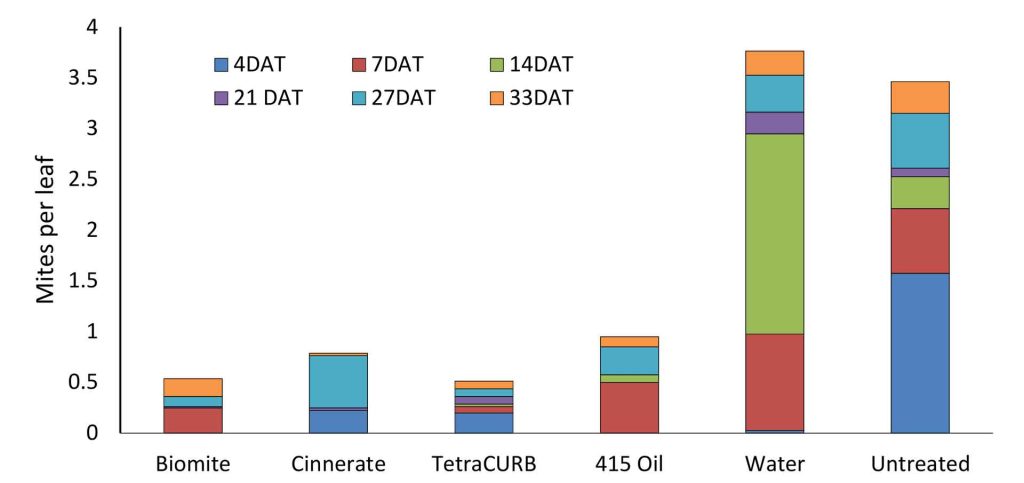
For More Information
Growers and PCAs in search of methods to control spider mites or other pests should consult the UC Integrated Pest Management web site at http://ucipm.ucanr.edu. Guidelines for the management of each pest contain information specific to the biological and other control methods available to organic farmers.
Disclaimer: Discussion of research findings necessitates using trade names. This does not constitute product endorsement, nor does it suggest products not listed would not be suitable for use.

